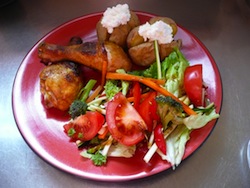According to the Oxford dictionary the first definition of diet is: “The kinds of food that a person, animal or community habitually eats.” The second definition is: “A special course of food to which a person restricts themselves, either to lose weight or for medical reasons.” Interestingly the word diet comes via Latin from the Greek word diaita which means: A way of life. For many the second definition has become a way of life. An endless cycle of food restrictions, losing weight, maybe, then eventually gaining weight again. And unfortunately often the weight added is even more than what was lost with the diet.
So why has diet become more about restrictions than just a word used to describe our natural food habits? You only have to open a magazine or read a newspaper to receive repeated messages about the latest diets and quick fix miracle. Whatever you do don’t google ‘diet’. With 144 million results confusion can be the only outcome.
If diets really work why are we bombarded with so many different messages? The truth is that diets don’t usually work in the long term. They just aren’t sustainable. Only about 5% of dieters are able to keep the weight off. More often than not their weight increases over time and so begins the endless cycle of yoyo dieting. This stresses the body as well as the mind. The dieter often believes that they didn’t have enough will power or they weren’t ‘good’ enough to maintain the diet and usually end up over eating or binge eating because the diet has been ruined anyway or they use food to comfort themselves. As a result they are now even bigger than when they started. Self esteem and confidence are slowly eroded.
This is where the Non-Diet approach comes in. Imagine someone telling you that you can eat whatever you feel like, whenever you feel like it. You just have to think about it first. Does this sound like a foreign and frightening concept? It is for many. But for most this is normal eating without the ‘diet’ rules.
The first step is to treat all food the same. Remove the good and bad tags. There are definitely foods that are more nutritious than others but basically food is food. Food is not meant to make you feel guilty. Food is eaten for many reasons; sociability, loneliness, celebration, we’re happy, we’re sad, bored, stressed and because it tastes good. The list is endless and you may have your own reasons. We all eat for reasons other than hunger but it is important to be aware of when and why we are eating. Hunger is the best reason but realistically it is not the only reason.
Step two is to eat mindfully. This means making yourself and your food important enough to eat away from distractions. Sit at the table, inside or out, and take your time. I’m not talking about chewing each mouthful 20 times but think about how the food smells, looks, how it feels in your mouth, what sort of texture does it have and of course what flavours you can taste. At first this activity requires a bit of effort and thought but once you become practiced at mindfully eating it becomes a quick natural appreciation of the food you are eating. Of course like everything in life this isn’t always possible but the idea is to take time when you can to appreciate your food.
Step three is to listen to your body. How many times have you decided to ignore your hunger signals and have water instead? Or you were really hungry but chose to only have a salad or an apple? Was this satisfying? Did you want to keep eating afterwards? Your body is preprogrammed with a huge range of signals such as tiredness, temperature, excitement and hunger. But for many these signals are ignored. Our body is our best indicator for what it requires. We just need to start listening again. Spend some time finding out how your body feels when you are full and when you are hungry. It may take some time to become aware of what it feels like to actually be hungry. Hunger is normal and a clear signal from your body that it needs satisfying.
This brings us to step four. Eating what will satisfy you. Before grabbing for the most convenient thing, take some time to ask yourself “how hungry am I” “what do I really feel like eating/what will satisfy me right now”. At the beginning as you allow yourself to eat all those foods you usually can’t while on a diet you may find that you eat a lot of foods you used to classify as ‘bad’. As the novelty wears off you will find yourself wanting these less and less. We are human after all so when someone tells us we can’t have something, we automatically want it twice as much and the reverse is true as well. You can have whatever you feel like but you need to ask yourself whether it will satisfy you at the time. Experiment, go shopping without checking food labels and buy whatever you think looks good to eat, try new recipes.
Along with eating what will satisfy you it is also important to eat when it will satisfy you. The body is not governed by a clock. Our lifestyles are governed by time but not our bodies. Take a few days to only eat when you are hungry. This will allow you to really get to know what hunger feels like for you and you may also see a pattern emerging of when you are ready to eat. This can be difficult in a family with young children but you could modify it so that you continue to eat with the children but change the size of your meals/snacks. This is only an exercise and is not something you need to commit to everyday but it stops the mindset that we must eat at specified times. There is no magical time in the evening that you must stop eating. If you find you are snacking in the evening for example while watching tv, again ask yourself “Am I really hungry?” If yes then “what is it that will really satisfy me?” Or are you eating out of habit or because of boredom? If you are, then get into the habit of eating your snacks at the table or find another distraction. If you are hungry then eat something satisfying. If you are eating for other reasons that is ok but it is important to be aware of that.
Take notice of how family and friends eat and how they feel about food. Talk to them about what they consider ‘normal’ eating. You will be amazed at how different normal is for everyone. Notice the difference between those who diet and those who don’t. Talk to that person who ‘eats whatever they want and never puts on any weight’. What is their normal?
Of course the other side of energy in (eating) is the energy out part of the equation. Again this shouldn’t be a hard task, but it does require a bit of effort. The majority of the energy from our food is used to maintain our bodies – breathing, temperature regulation, digestion, brain etc etc. On top of that is physical activity. This helps to keep us fit and can help us to feel better about ourselves. Physical activity includes all the day to day activities like housework, walking between desk and printer, taking the stairs, playing with the kids…. Unfortunately for most of us we don’t get enough physical activity in our day so we have to make a bit of time for it. The trick is to do something you like doing. Some examples could be dancing lessons, walking the dog, swimming, yoga, pilates, rock climbing, dancing in the lounge with your children, the list is endless. It doesn’t matter what it is as long as you enjoy it because if you enjoy it you are more likely to get out there and do it. I walk the dog, which gets me out with the children either in the buggy or on scooters. Two evenings a week I go to yoga. My husband finishes dinner and I get to come home to the kids already in bed. I am a little rushed to get out the door in time but the extra effort is so worth the time out I get for myself. Again this is all about getting into a habit. Once you start missing something because you haven’t done it in a while you know you’ve got the right activity. It’s not always easy to have the motivation to do something but it is usually worth the extra bit of effort.
The final part of this approach is to be kind to yourself. Be self-accepting. Become comfortable with your body. Talk to yourself with respect and encouragement. Everyone is beautiful but most of us focus on the negative aspects of our body and forget to acknowledge the positive.
This is not a miracle cure. It will not make you supermodel thin. It will not make you a natural athlete. It does naturally encourage you to eat healthier as you respond to your body’s messages. It will bring food back into context and allow you to have a life that is not ruled by food and diet rules. It can be a difficult concept to feel comfortable with but most people I work with feel so much freer and more at peace with themselves as they work through the steps. This approach allows your body to find the weight it is most comfortable with and it teaches you to be comfortable with whatever that is.
For more information and inspiration have a look at Rick Kausman’s book “If Not Dieting, Then What?” It’s definitely worth a read. Or you can contact me at www.foodhabits.co.nz.








Great article Andrea, love this approach. So important to model this for our kids – and of course they can teach us so much about mindfulness, being in tune with our bodies and the sheer delight of food!